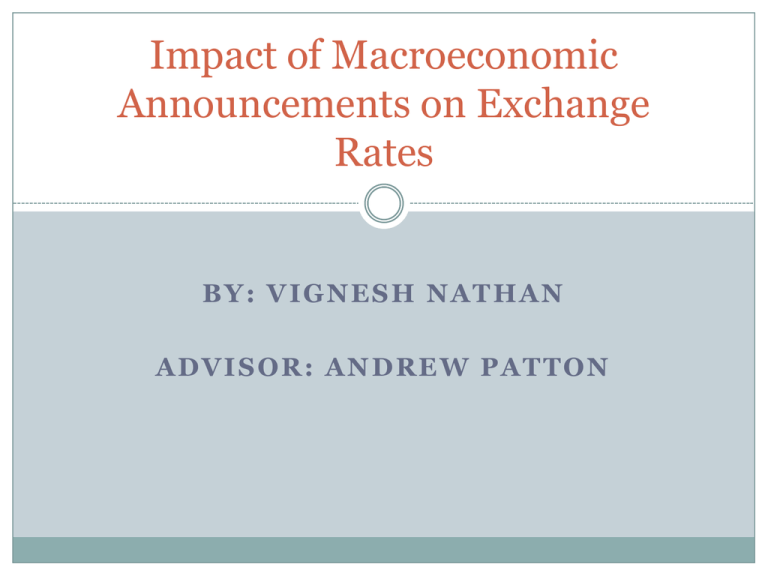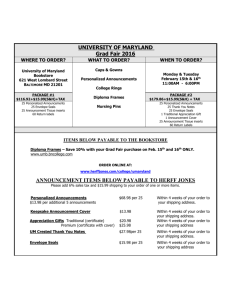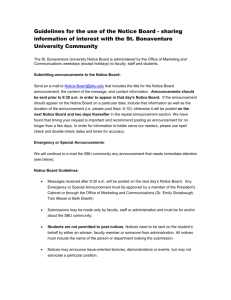Impact of Macroeconomic Announcements on Exchange Rates
advertisement

Impact of Macroeconomic
Announcements on Exchange
Rates
BY: VIGNESH NATHAN
ADVISOR: ANDREW PATTON
Motivation
“…the disappointing [unemployment] data initially sent the Dow
Jones Industrial Average down 160 points”
-Wall Street Journal, 8/7/2011
However, the effects of a negative (or positive) announcement is
very short-lived.
“…but it recovered to end the day off 21 points to 10,653.56.”
Research Question: How influential are certain types of
macroeconomic news on asset prices, and how long-lived is their
effect?
Basic Ideology
Initial Foreign
Exchange Rate
Reactionary
Foreign
Exchange Rate
Macroeconomic
Announcement
5 minutes
5 minutes
• It is a central assumption of this study that within this 10-minute interval, the
announcement drives all foreign exchange trading and is responsible for all
resulting fluctuations in prices.
• For this precise reason, we can treat the announcement as a “natural
experiment.” This will allow me to use a relatively simple model.
Methodology
The model is incredibly simple:
Rt = α + βSt + ut
Where,
Rt is the ten minute return on the currency, given by:
Rt = ln(FXt+5min) – ln(FXt-5min)
St is the announcement surprise, given by:
St = Announcementt - Expectationt
ut is the error term.
Canadian Unemployment Rate Announcement Effects
0.01
Denotes a
depreciation of
the Canadian
dollar.
Ten Minute Return
0.005
-0.005
0
-0.004
-0.003
-0.002
-0.001
0
0.001
0.002
0.003
0.004
Denotes an
appreciation of
the Canadian
dollar.
-0.005
-0.01
-0.015
Unemployment Rate Surprise
0.005
y = 1.0193x - 0.0004
R² = 0.1697
Canadian Monthly Retail Sales Announcement Effects
0.008
0.006
0.004
Denotes a
depreciation of
the Canadian
dollar.
y = -0.1944x + 9E-05
R² = 0.47
Ten Minute Return
0.002
-0.03
0
-0.02
-0.01
0
0.01
-0.002
-0.004
-0.006
-0.008
Montly Retail Sale Rate Surprise
0.02
0.03
Denotes an
appreciation of
the Canadian
dollar.
Summary Statistics for All Announcements
A. Overall
Inflation
Unemployment
Constant
t-stat
Slope
t-stat
R-squared
#
Observations
GDP
Retail Sales
MoM, Core
MoM, Headline
YoY, Core
YoY, Headline
-0.0003731 -0.0001296
0.0000877
0.0002
0.000095
0.000179
0.0001036
0.45
0.80
0.38
0.71
0.41
-0.1944157 -0.4523274
-0.4543301
-0.440118
-0.4199538
-0.90
-0.56
1.019261 -0.4176449
3.73
-3.31
-7.65
-3.48
-3.60
-3.50
-3.25
0.1697
0.1402
0.47
0.1529
0.1623
0.1548
0.1362
70
69
68
69
69
69
69
Conclusion: Interestingly, all announcements have statistically significant effects
on the foreign exchange market.
The unemployment rate seems to be the most powerful and sought-after
announcement, with a slope that doubles that of the next most influential
announcement.
Asymmetric Response
Very widely cited phenomenon in finance, states that
foreign exchange markets respond in an unbalanced
manner to different types of surprises, either given by its
value (positive vs. negative, large vs. small) or its
environment (good times vs. bad times)
Asymmetric Response Tests
Positive Surprises
Negative Surprises
Large Surprises (St > median[abs{St}])
Small Surprises (St <= median[abs{St}])
Pre-Recession (Pre-January 2008)
Recession (Post-January 2008)
Pre-Recession, Positive
Pre-Recession, Negative
Recession, Positive
Recession, Negative
Observations – Asymmetric Response
Pre-recession announcements are significantly more
influential than those made during the recession.
“Bad news”—positive surprises of unemployment
and negative surprises of anything else—tend to have
bigger impacts than “good news”
This was true for unemployment, YoY Core/Headline inflation
Large surprises have disproportionately big effects
compared to small surprises.
For most macroeconomic announcements, small surprises
were not statistically significant.
Future
Perform the same analysis, using identical announcements, for three other
countries.
Other Countries
Australia
USD-AUD
United Kingdom
USD-GBP
United States
USD-EUR
USD-AUD
USD-GBP
USD-CAD
Troubleshooting/Questions
Asymmetric Response: How few observations is too
few?
What are the weaknesses of only using one exchange
rate to study certain currencies?
How frail is the assumption that the announcement
is the most significant driver of foreign exchange
movements over the surrounding 10-minute
interval?
Should I expand the time horizon?
Why are announcements less influential during the
recession?






